German actor Mathias Wieman (1902-1969) starred in more than 50 films was and made Staatsschauspieler, the highest honour attainable by an actor in Germany. After the war he became a popular supporting actor in films.
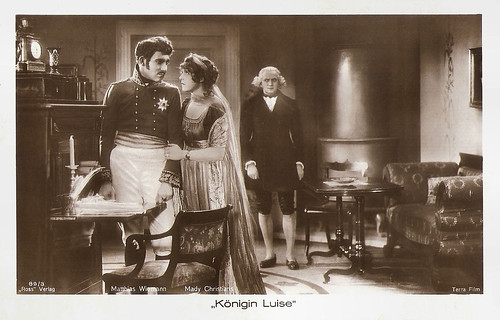
German postcard by Ross Verlag, no. 89/3, 1925-1935. Photo: Terra Film. Publicity still for Königin Luise/Queen Louise (Karl Grune, 1927) with Mady Christians.
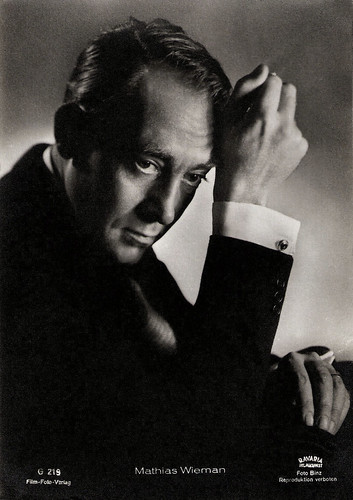
German postcard by Film-Foto-Verlag, no. G 219. Photo: Binz / Bavaria Filmkunst.
Mathias Wieman was born Carl Heinrich Franz Mathias Wieman in Osnabrück in 1902. He was the only son of Carl Philipp Anton Wieman and his wife Louise.
Raised in Osnabrück, Wiesbaden and Berlin, where he studied four terms of philosophy, history of art and languages, Wieman wanted to become an airplane designer and flier.
He started his acting career at the Deutsches Theater in Berlin under the direction of Max Reinhardt. His debut role was Moritz Stiefel in Frank Wedekind’s Frühlings Erwachen (Spring Awakening).
In the early 1920s, he was a member of the Holtorf-Truppe, a stock theatre group that included future director Veit Harlan. His fellow stage actors included his future wife, Erika Meingast, Marlene Dietrich, and Max Schreck (the vampire in Nosferatu).
Later he began working in silent films, including Mata Hari, die rote Tänzerin/Mata Hari: the Red Dancer (Friedrich Feher, 1927), Feme (Richard Oswald, 1927), Königin Luise/Queen Louise (Karl Grune, 1927) opposite Mady Christians, and Das Land ohne Frauen/Bride Number 68 (Carmine Gallone, 1929) starring Conrad Veidt.
In 1930, along with Leni Riefenstahl, he appeared in the mountain film Stürme über dem Mont Blanc/Avalanche (Arnold Fanck, 1930), and in 1932 he played the male lead in Riefenstahl's Das Blaue Licht/The Blue Light (Béla Balázs, Leni Riefenstahl, 1932).
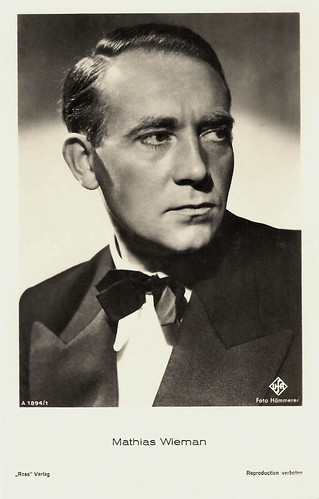
German postcard by Ross Verlag, no. A 1894/1, 1937-1938. Photo: Ufa / Hämmerer.
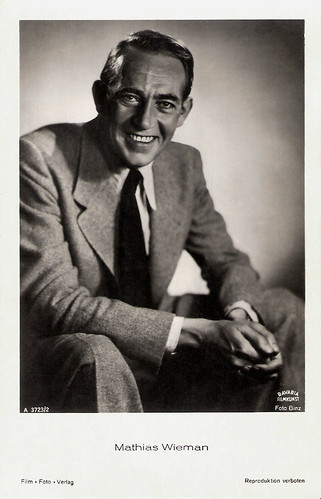
German postcard by Film-Foto-Verlag, no. A 3723/2, 1941-1944. Photo: Binz / Bavaria Filmkunst.
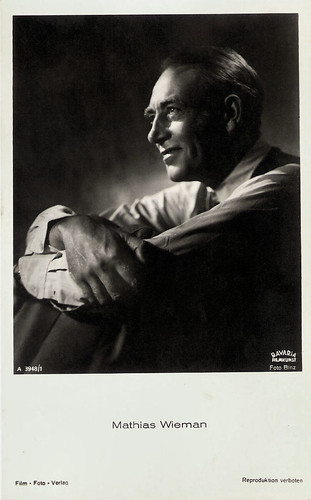
German postcard by Film-Foto-Verlag, no. A 3948/1, 1941-1944. Photo: Binz / Bavaria Filmkunst.
During the 1930s, at the height of his film career, Mathias Wieman acted in such productions as Mensch ohne Namen/The Man Without a Name (Gustav Ucicky, 1932), Die Herrin von Atlantis/L’ Atlantide/Queen of Atlantis (Georg Wilhelm Pabst, 1932) with Brigitte Helm, Die Gräfin von Monte Christo/The Countess of Monte Cristo (Karl Hartl, 1932), and Fräulein Hoffmanns Erzählungen/Tales of Miss Hoffmann (Carl Lamac, 1933) with Anny Ondra,
After the rise of the Nazis he acted in Der Schimmelreiter/The Rider of the White Horse (Hans Deppe, Curt Oertel, 1934), Viktoria (Carl Hoffmann, 1935) with Luise Ullrich, Patrioten/Patriots (Karl Ritter, 1937), and Togger (Jürgen von Alten, 1937) with Paul Hartmann.
He had an international success with his appearance in Die ewige Maske/The Eternal Mask (Werner Hochbaum, 1935). The film was in 1937 nominated for an award at the Venice Film Festival, and awarded with the American National Board of Review Award for Best Foreign Film.
Also in 1937, Wieman was made Staatsschauspieler, an honorary title bestowed by the German government and the highest honour attainable by an actor in Germany. In 1936 Wieman had produced the Frankenburger Würfelspiel of the Nazi playwright Eberhard Wolfgang Möller in association with the 1936 Summer Olympics and the inauguration of the Dietrich-Eckart-Bühne, and also played the Black Knight.
However, according to director Leopold Lindtberg, Wieman was eventually classed as ‘persona non grata’ by Joseph Goebbels, the Minister of Propaganda who was responsible for film production in Germany. This reduced Wieman’s activity. He took part in a few films like the Propaganda film Ich klage an/I Accuse (Wolfgang Liebeneiner, 1941) - possibly an act of punishment, Das andere Ich/The other I (Wolfgang Liebeneiner, 1941), Paracelsus (Georg Wilhelm Pabst, 1943) starring Werner Krauss, Träumerei/Dreaming (Harald Braun, 1944) opposite Hilde Krahl, and Wie sagen wir es unseren Kindern/How Do We Tell Our Children (Hans Deppe, 1945).
After the failed 20 July 1944 plot to assassinate Adolf Hitler, Mathias and his wife Erika helped the family of Count Fritz-Dietlof von der Schulenburg. This assistance, at great risk to themselves, is detailed by Charlotte von der Schulenburg in the book Courageous Hearts: Women and the Anti-Hitler Plot of 1944.
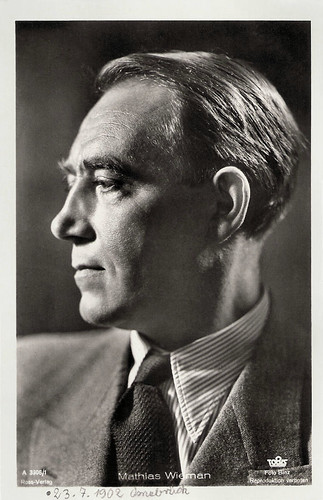
German postcard by Ross Verlag, no. A 3306/1, 1941-1944. Photo: Binz / Tobis.
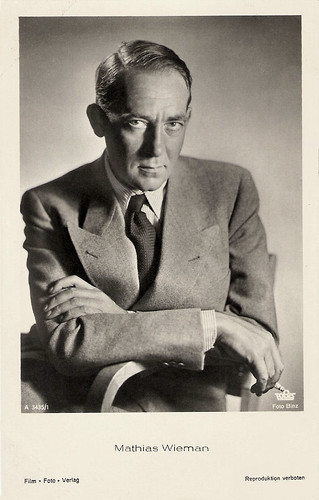
German postcard by Film-Foto-Verlag, no. A 3435/1, 1941-1944. Photo: Tobis / Binz.
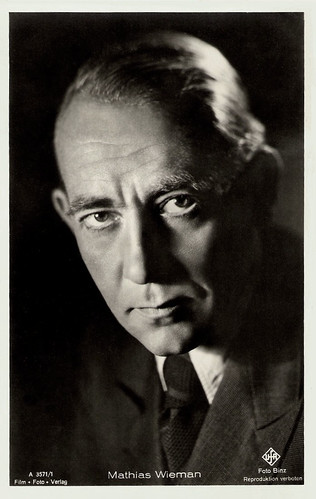
German postcard by Film-Foto-Verlag, no. A 3571/1, 1941-1944. Photo: Ufa / Binz.
After World War II, Mathias Wieman was able to work more intensively in the film business again, normally in supporting roles. To his fairly well-known work belongs Herz der Welt/The Alfred Nobel Story (Harald Braun, 1952) in which Wieman portrayed Dr. Alfred Nobel, Solange du da bist/As Long as You're Near Me (Harald Braun, 1953), Der letzte Sommer/The Last Summer (Harald Braun, 1954), and Reifende Jugend/Ripening Youth (Ulrich Erfurth, 1955).
He appeared opposite Romy Schneider and Horst Buchholz in Robinson soll nicht sterben/The Girl and the Legend (Josef von Báky, 1957), and opposite Ingrid Bergman in Rossellini's La Paura/Fear (Roberto Rossellini, 1954).
Two of these films were in competition at the Cannes Film Festival: Herz Der Welt in 1952, and Solange Du Da Bist in 1954.
He also made many records of classic stories where he would narrate the story accompanied by orchestral music. On stage, Wieman appeared in countless productions, including Goethe's Faust, Pygmalion by George Bernard Shaw, Six Characters in Search of an Author by Luigi Pirandello, and Im Dickicht der Städte (In The Jungle of Cities) by Bertolt Brecht.
After the war Mathias Wieman and his wife Erika Meingast moved to Switzerland. In 1969 he died of cancer in Zurich, soon followed by his wife. The couple had no children.

East-German postcard by VEB Volkskunstverlag Reichenbach i.V., no. G 704, 1956. Photo: NDF / Schorchtfilm. Publicity still for Herz der Welt/The Alfred Nobel Story (Harald Braun, 1952).
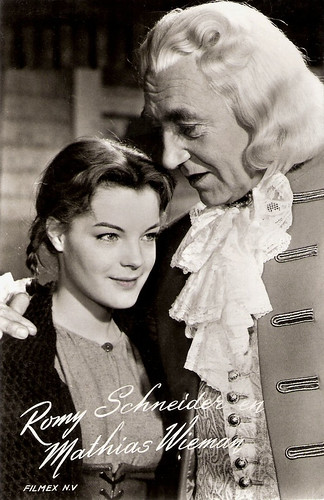
Dutch postcard by Takken, Utrecht, no. AX 3078. Photo: Filmex NV. Publicity still for Robinson soll nicht sterben/The Girl and the Legend (Josef von Báky, 1957) with Romy Schneider and Mathias Wieman.
Sources: Dieter Svensson (Mathias Wieman Site), Wikipedia, and IMDb.

German postcard by Ross Verlag, no. 89/3, 1925-1935. Photo: Terra Film. Publicity still for Königin Luise/Queen Louise (Karl Grune, 1927) with Mady Christians.

German postcard by Film-Foto-Verlag, no. G 219. Photo: Binz / Bavaria Filmkunst.
Leni Riefenstahl
Mathias Wieman was born Carl Heinrich Franz Mathias Wieman in Osnabrück in 1902. He was the only son of Carl Philipp Anton Wieman and his wife Louise.
Raised in Osnabrück, Wiesbaden and Berlin, where he studied four terms of philosophy, history of art and languages, Wieman wanted to become an airplane designer and flier.
He started his acting career at the Deutsches Theater in Berlin under the direction of Max Reinhardt. His debut role was Moritz Stiefel in Frank Wedekind’s Frühlings Erwachen (Spring Awakening).
In the early 1920s, he was a member of the Holtorf-Truppe, a stock theatre group that included future director Veit Harlan. His fellow stage actors included his future wife, Erika Meingast, Marlene Dietrich, and Max Schreck (the vampire in Nosferatu).
Later he began working in silent films, including Mata Hari, die rote Tänzerin/Mata Hari: the Red Dancer (Friedrich Feher, 1927), Feme (Richard Oswald, 1927), Königin Luise/Queen Louise (Karl Grune, 1927) opposite Mady Christians, and Das Land ohne Frauen/Bride Number 68 (Carmine Gallone, 1929) starring Conrad Veidt.
In 1930, along with Leni Riefenstahl, he appeared in the mountain film Stürme über dem Mont Blanc/Avalanche (Arnold Fanck, 1930), and in 1932 he played the male lead in Riefenstahl's Das Blaue Licht/The Blue Light (Béla Balázs, Leni Riefenstahl, 1932).

German postcard by Ross Verlag, no. A 1894/1, 1937-1938. Photo: Ufa / Hämmerer.

German postcard by Film-Foto-Verlag, no. A 3723/2, 1941-1944. Photo: Binz / Bavaria Filmkunst.

German postcard by Film-Foto-Verlag, no. A 3948/1, 1941-1944. Photo: Binz / Bavaria Filmkunst.
Actor of the State and Persona non grata
During the 1930s, at the height of his film career, Mathias Wieman acted in such productions as Mensch ohne Namen/The Man Without a Name (Gustav Ucicky, 1932), Die Herrin von Atlantis/L’ Atlantide/Queen of Atlantis (Georg Wilhelm Pabst, 1932) with Brigitte Helm, Die Gräfin von Monte Christo/The Countess of Monte Cristo (Karl Hartl, 1932), and Fräulein Hoffmanns Erzählungen/Tales of Miss Hoffmann (Carl Lamac, 1933) with Anny Ondra,
After the rise of the Nazis he acted in Der Schimmelreiter/The Rider of the White Horse (Hans Deppe, Curt Oertel, 1934), Viktoria (Carl Hoffmann, 1935) with Luise Ullrich, Patrioten/Patriots (Karl Ritter, 1937), and Togger (Jürgen von Alten, 1937) with Paul Hartmann.
He had an international success with his appearance in Die ewige Maske/The Eternal Mask (Werner Hochbaum, 1935). The film was in 1937 nominated for an award at the Venice Film Festival, and awarded with the American National Board of Review Award for Best Foreign Film.
Also in 1937, Wieman was made Staatsschauspieler, an honorary title bestowed by the German government and the highest honour attainable by an actor in Germany. In 1936 Wieman had produced the Frankenburger Würfelspiel of the Nazi playwright Eberhard Wolfgang Möller in association with the 1936 Summer Olympics and the inauguration of the Dietrich-Eckart-Bühne, and also played the Black Knight.
However, according to director Leopold Lindtberg, Wieman was eventually classed as ‘persona non grata’ by Joseph Goebbels, the Minister of Propaganda who was responsible for film production in Germany. This reduced Wieman’s activity. He took part in a few films like the Propaganda film Ich klage an/I Accuse (Wolfgang Liebeneiner, 1941) - possibly an act of punishment, Das andere Ich/The other I (Wolfgang Liebeneiner, 1941), Paracelsus (Georg Wilhelm Pabst, 1943) starring Werner Krauss, Träumerei/Dreaming (Harald Braun, 1944) opposite Hilde Krahl, and Wie sagen wir es unseren Kindern/How Do We Tell Our Children (Hans Deppe, 1945).
After the failed 20 July 1944 plot to assassinate Adolf Hitler, Mathias and his wife Erika helped the family of Count Fritz-Dietlof von der Schulenburg. This assistance, at great risk to themselves, is detailed by Charlotte von der Schulenburg in the book Courageous Hearts: Women and the Anti-Hitler Plot of 1944.

German postcard by Ross Verlag, no. A 3306/1, 1941-1944. Photo: Binz / Tobis.

German postcard by Film-Foto-Verlag, no. A 3435/1, 1941-1944. Photo: Tobis / Binz.

German postcard by Film-Foto-Verlag, no. A 3571/1, 1941-1944. Photo: Ufa / Binz.
Alfred Nobel
After World War II, Mathias Wieman was able to work more intensively in the film business again, normally in supporting roles. To his fairly well-known work belongs Herz der Welt/The Alfred Nobel Story (Harald Braun, 1952) in which Wieman portrayed Dr. Alfred Nobel, Solange du da bist/As Long as You're Near Me (Harald Braun, 1953), Der letzte Sommer/The Last Summer (Harald Braun, 1954), and Reifende Jugend/Ripening Youth (Ulrich Erfurth, 1955).
He appeared opposite Romy Schneider and Horst Buchholz in Robinson soll nicht sterben/The Girl and the Legend (Josef von Báky, 1957), and opposite Ingrid Bergman in Rossellini's La Paura/Fear (Roberto Rossellini, 1954).
Two of these films were in competition at the Cannes Film Festival: Herz Der Welt in 1952, and Solange Du Da Bist in 1954.
He also made many records of classic stories where he would narrate the story accompanied by orchestral music. On stage, Wieman appeared in countless productions, including Goethe's Faust, Pygmalion by George Bernard Shaw, Six Characters in Search of an Author by Luigi Pirandello, and Im Dickicht der Städte (In The Jungle of Cities) by Bertolt Brecht.
After the war Mathias Wieman and his wife Erika Meingast moved to Switzerland. In 1969 he died of cancer in Zurich, soon followed by his wife. The couple had no children.

East-German postcard by VEB Volkskunstverlag Reichenbach i.V., no. G 704, 1956. Photo: NDF / Schorchtfilm. Publicity still for Herz der Welt/The Alfred Nobel Story (Harald Braun, 1952).

Dutch postcard by Takken, Utrecht, no. AX 3078. Photo: Filmex NV. Publicity still for Robinson soll nicht sterben/The Girl and the Legend (Josef von Báky, 1957) with Romy Schneider and Mathias Wieman.
Sources: Dieter Svensson (Mathias Wieman Site), Wikipedia, and IMDb.
No comments:
Post a Comment